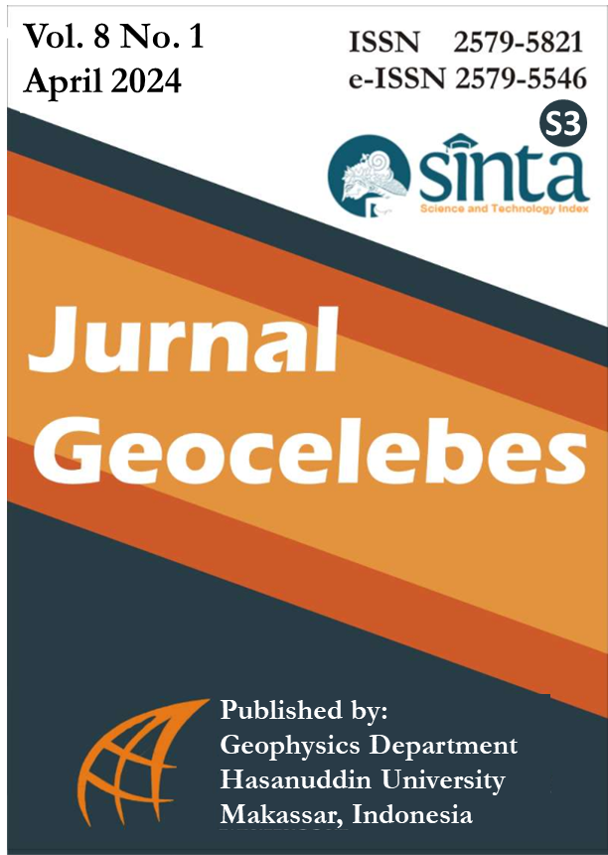Application of Seismic Refraction Tomography in Determining the Soil Hardness Level in IKN Nusantara Area
DOI:
https://doi.org/10.20956/geocelebes.v8i1.32159Keywords:
Infrastructure, New Capital Territory of Nusantara (IKN Nusantara), Seismic Refraction Tomography (SRT), VpAbstract
Numerous studies supporting infrastructure construction are currently underway in the New Capital Territory of Nusantara (IKN Nusantara). A geophysical method known as Seismic Refraction Tomography (SRT) has been employed within the IKN Nusantara to identify hard and soft layers based on the P-wave velocity (Vp). The data acquisition involved 24 channels of geophone spaced at intervals 3 and 4 meters. Measurements were conducted alongfour trajectories of 69 and 92 meters, reaching penetration depths of 12 – 20 meters. P-wave velocity values ranging between 200 – 3500 m/s were recorded. Additionally, the Unconfined Compressive Strength (UCS) value was determined using an empirical equation tailored for mudrock-shale lithology, establishing the correlation between Vp and UCS. In the shallow depths of 0 – 3 meters, UCS values indicated levels below 20 MPa, classifying the materials as having low to medium hardness. However, at depths greater than 3 meters, this layer transitioned to material with high hardness levels, as evidenced by UCS rate exceeding 20 MPa across all trajectories. This suggest that the IKN Nusantara is conducive to infrastructure development.
References
Abudeif, A. M., Aal, G. Z. A., Abdelbaky, N. F., Gowad, A. M. A., & Mohammed, M. A. (2023). Evaluation of Engineering Site and Subsurface Structures Using Seismic Refraction Tomography: A Case Study of Abydos Site, Sohag Governorate, Egypt. Applied Sciences, 13(4), 2745. https://doi.org/10.3390/app13042745
Adewoyin, O. O., Joshua, E. O., Akinyemi, M. L., Omeje, M., & Adagunodo, T. A. (2021). Evaluation of Geotechnical Parameters of Reclaimed Land from Near-Surface Seismic Refraction Method. Heliyon, 7(4), E06765. https://doi.org/10.1016/j.heliyon.2021.e06765
Akisanmi, P. (2022). Classification of Clay Minerals. Mineralogy (M. René (ed.); p. Ch. 12). IntechOpen. https://doi.org/10.5772/intechopen.103841
Amran, Y., & Pradana, D. Y. (2023). Parameter Nilai Kuat Tekan Bebas Tanah terhadap Tingkat Kepadatan Tanah Lempung Ekspansif. Teknologi Aplikasi Konstruksi (TAPAK), 12(2), 166–178. http://dx.doi.org/10.24127/tp.v12i2.2595
Asamoah, K. N., Seidu, J., Ewusi, A., & Ansah, E. (2018). Geotechnical Investigation at Sanzule Beach, Ghana, Using Seismic Refraction Tomography. IJISET-International Journal of Innovative Science, Engineering & Technology, 5(2), 45–53. https://ijiset.com/vol5/v5s2/IJISET_V5_I02_05.pdf
Awang, H., Rashidi, N.R.A., Yusof, M., & Muhammad, K. (2017). Correlation Between P-wave Velocity and Strength Index for Shale to Predict Uniaxial Compressive Strength Value. MATEC Web of Conferences 103, 07017. https://doi.org/10.1051/matecconf/201710307017
Bachtiar, A. (2022). Aspek geologi untuk mitigasi bencana Ibu Kota Nusantara. National Webinar. https://www.its.ac.id/tgeofisika/wp-content/uploads/sites/33/2022/11/Materi-Dr-Andang-Bachtiar.pdf
Efendi, A. W. (2023). Pemodelan Penurunan Tanah Di Ibu Kota Negara Nusantara Menggunakan Analisis Numerik Metode Elemen Hingga Lisa V.8. Paduraksa: Jurnal Teknik Sipil Universitas Warmadewa, 12(1), 21–29. https://doi.org/10.22225/pd.12.1.5643.21-29
El Hameedy, M. A., Mabrouk, W. M., Dahroug, S., Youssef, M. S., & Metwally, A. M. (2023). Role of Seismic Refraction Tomography (SRT) in bedrock mapping; case study from industrial zone, Ain-Sokhna area, Egypt. Contributions to Geophysics and Geodesy, 53(2), 111–128. https://doi.org/10.31577/congeo.2023.53.2.2
Ezrahayu, P. & Supriyanto, S. (2021). Identifikasi Sesar di Bawah Permukaan yang Dapat Menyebabkan Gempa Berdasarkan Metode First Horizontal Derivative dan Second Vertical Derivative di Kabupaten Penajam Paser Utara, Kalimantan Timur. Jurnal Geosains Terapan 4(1), 15–22. https://geosainsterapan.id/index.php/id/issue/download/6/6
Jabrane, O., Martinez-Pagan, P., Martinez-Segura, M. A., Alcala, F. J., El Azzab, D., Vásconez-Maza, M. D., & Charroud, M. (2023). Integration of Electrical Resistivity Tomography and Seismic Refraction Tomography to Investigate Subsiding Sinkholes in Karst Areas. Water. 15(12), 2192. https://doi.org/10.3390/w15122192
Kessler, J. A., Schmitt, D.R., Chen, X., Evans, J. P., & Shervains, J. W.. (2017). Predicting Uniaxial Compressive Strength from Empirical Relationships between Ultrasonic P wave Velocities, Porosity, and Core Measurements in a Potential Geothermal Reservoir, Snake River Plain, Idaho. American Rock Mechanics Association (ARMA), 17-391. https://www.osti.gov/servlets/purl/1749943
Ohlmacher, G. C. (2000). The Relationship Between Geology and Landslide Hazards of Atchison, Kansas, and Vicinity. Current Research in Earth Science, 244, 1–16. https://doi.org/10.17161/cres.v0i244.11833
Oladotun, A. O., Oluwagbemi, J. E., Lola, A. M., Maxwell, O., & Sayo, A. (2019). Predicting Dynamic Geotechnical Parameters in Near-Surface Coastal Environment. Cogent Engineering, 6(1), 1588081. https://doi.org/10.1080/23311916.2019.1588081
Opemipo, O. D., Moroff, O., Sunday, O., Victor, O., & Christopher, B. (2022). Subgrade Soil Evaluation Using Integrated Seismic Refraction Tomography and Geotechnical Studies: A Case of Ajaokuta-Anyigba Federal Highway, North-Central Nigeria. NRIAG Journal of Astronomy and Geophysics, 11(1), 293–305. https://doi.org/10.1080/20909977.2022.2094530
Pratama, A. W., Iswan, I., & Jafri, M. (2015). Korelasi Kuat Tekan dengan Kuat Geser pada Tanah Lempung yang Didistribusi dengan Variasi Campuran Pasir. Journal Rekayasa Sipil Dan Desain (JRSDD), 3(1), 157–170. https://journal.eng.unila.ac.id/index.php/jrsdd/article/view/434
Poulos, H. G. (2021). Use of shear wave velocity for foundation design. Geotechnical and Geological Engineering, 40(2), 1921–1938. https://doi.org/10.1007/s10706-021-02000-w
Shin, B.-S., Wientgens, L., Schaab, M., & Shutin, D. (2022). Near-Surface Seismic Measurements in Gravel Pit, over Highway Tunnel and Underground Tubes with Ground Truth Information as an Open Data Set. Sensors, 22(17), 6687. https://doi.org/10.3390/s22176687
Supriatna, S. Sukardi, R, & R. Rustandi. (1995). Peta Geologi Bersistem, Lembar Samarinda, Kalimantan skala 1:250.000. Pusat Penelitian dan Pengembangan Geologi.
Susilawati, R. (2022). Kajian geologi dalam rencana pembangunan IKN nusantara. Diskusi IAGI "Menyongsong IKN Nusantara dari Perspektif Kebumian". https://www.iagi.or.id/web/digital/43/Hasil-Kajian-Geologi-dalam-Rencana-Pembangunan-IKN-Nusantara-(1).pdf
Tanjung, D., Sarifah, J., & Ardian, J. P. (2023). Pengaruh Nilai Kuat Tekan Bebas terhadap Penambahan Abu Sekam Padi pada Tanah Lempung. Jurnal Teknik Sipil. 2(1), 68–77. https://jurnal.uisu.ac.id/index.php/JTSIP/article/view/7662
Whiteley, J. S., Chambers, J. E., Uhlemann, S., Wilkinson, P. B., & Kendall, J. M. (2018). Geophysical Monitoring of Moisture-Induced Landslides: A Review. Review of Geophysics, 57(1), 106–145. https://doi.org/10.1029/2018RG000603
Downloads
Published
How to Cite
Issue
Section
License
Authors who publish with this journal agree to the following terms:
- Authors retain copyright and grant the journal right of first publication with the work simultaneously licensed under a Creative Commons Attribution License that allows others to share the work with an acknowledgement of the work's authorship and initial publication in this journal.
- Authors are able to enter into separate, additional contractual arrangements for the non-exclusive distribution of the journal's published version of the work (e.g., post it to an institutional repository or publish it in a book), with an acknowledgement of its initial publication in this journal.
- Authors are permitted and encouraged to post their work online (e.g., in institutional repositories or on their website) prior to and during the submission process, as it can lead to productive exchanges, as well as earlier and greater citation of published work (See The Effect of Open Access).





